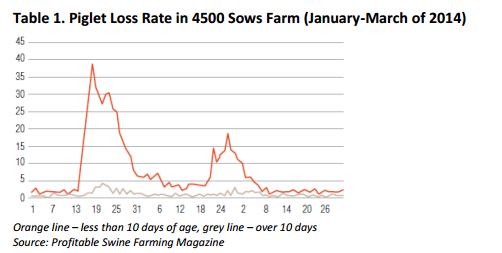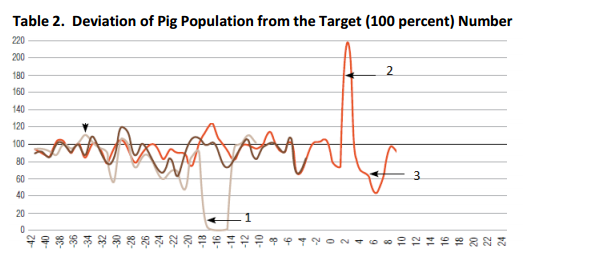



Multiple PED Outbreaks Likely to Impact Ukrainian Pork Production
UKRAINE - According to Ukrainian swine industry groups, several Porcine Epidemic Diarrhoea (PED) cases were registered in different regions of Ukraine since spring of 2014.The disease is not on the OIE list of notifiable terrestrial and aquatic animal diseases, although its economic impact on production is significant. According to Ukrainian veterinarians, the disease is highly contagious and destroys 100 per cent of young piglets infected which causes a major brake in the production cycle.
PED outbreaks in Ukraine have had an average length of four to seven weeks, at which point, if not properly contained, the farm could relapse with a subsequent outbreak (see table 1). During the outbreak period, average losses can be calculated at approximately 78 piglets per each hundred sows with average production halt at four weeks.
To date, Ukraine’s Veterinary and Phytosanitary Service (VS) do not recognize the danger of the PED virus epidemic. When contacted by FAS/Kyiv, they claimed the disease is not registered in the country.
It should be noted that the disease is not the OIE list of reportable disease which may be influencing VS’ position on acknowledging the PED epidemic. FAS/Kyiv has also been in contact with the largest swine producer association, the Swine Breeders of Ukraine (SB), and discovered that SB members have reported three-to-four cases of PED this year.
Additional cases are known in non-member farms. Swine farmers in Ukraine are on alert, and as a result, have reportedly increased biosecurity practices as a preventive measure. Special attention has been paid to disinfecting trucks and tightening critical inspection points such as entry ways/exits. According to internet sources, the disease spread in Ukraine accelerated in November/December 2014.
Most of the comments on Ukraine’s situation are provided by renowned international veterinarian consultant to the animal production industry: Dr John Carr. Dr Carr is considered one of the world’s experts on the PED virus.
While Ukraine is not a major producer or exporter of pork products, according to Dr Carr, a PED virus outbreak in several sow farms in Ukraine could lead to the deaths of 30 to 35 million pigs in Europe, and have a major impact on global pig production numbers. Dr Carr was invited to Ukraine by SB in spring 2014, but later continued his private consultancy practice on individual infected farms.
In November, Dr Carr spent ten days in Ukraine visiting three farms with PED outbreaks. Although "still struggling to get [it] (the virus) typed because the Ukraine does not have the technology and obviously the people in Ukraine have some slightly other issues to worry about," he mentioned in an interview to “Siemens Says” (a respected Canadian agribusiness news blog).
"Normally, I’d send my samples to Russia but they are not quite talking to me at the moment either, making this situation a bit awkward." Dr Carr has dealt with PED outbreaks in different parts of the world for over 20 years and has experience spotting the virus as early as 1972.
According to Dr Carr, the PED virus types found in Ukraine are alike those found in China (since 2010) and the United States (since 2013), but different from earlier EU cases. Dr Carr warns that he "suspect(s) this is the beginning of the European outbreak."
He warns that his professional estimation is that the PED virus will kill 25 to 35 million pigs over the next 18 months. Dr Carr adds that "of the three big farms I have in Ukraine, two are under control, and the other one is getting under control," and categorises the impact of Ukraine’s outbreaks as more serious than what he had encountered in Asia.
Dr Carr claimed to have lost as much as 10,000 pigs in just four days in farms he’s worked in, and added that bigger farms would have larger problems. Although information on impacted farms in Ukraine is not publicly available, the size of the losses is confirmed for at least one of the top five largest Ukrainian swine producers in the country who is currently struggling with the disease.
Farm managers, hog producers, and farm workers should tighten up biosecurity practices as the best line of defense against this highly contagious strain. They should also work in concert with other farms in neighboring communities.
This might be easier said than done, as half of the Ukraine’s swine production is in backyard farms. In 2014, Ukrainian farms were unable to dodge the impact of this previously unknown disease which is now on its second epidemic wave.
Some farmers have made additional mistakes by inseminating available sows in an attempt to return to target swine population numbers too quickly (see Table 2). The PED virus’ impact on farms may last for as long as 18 months.










